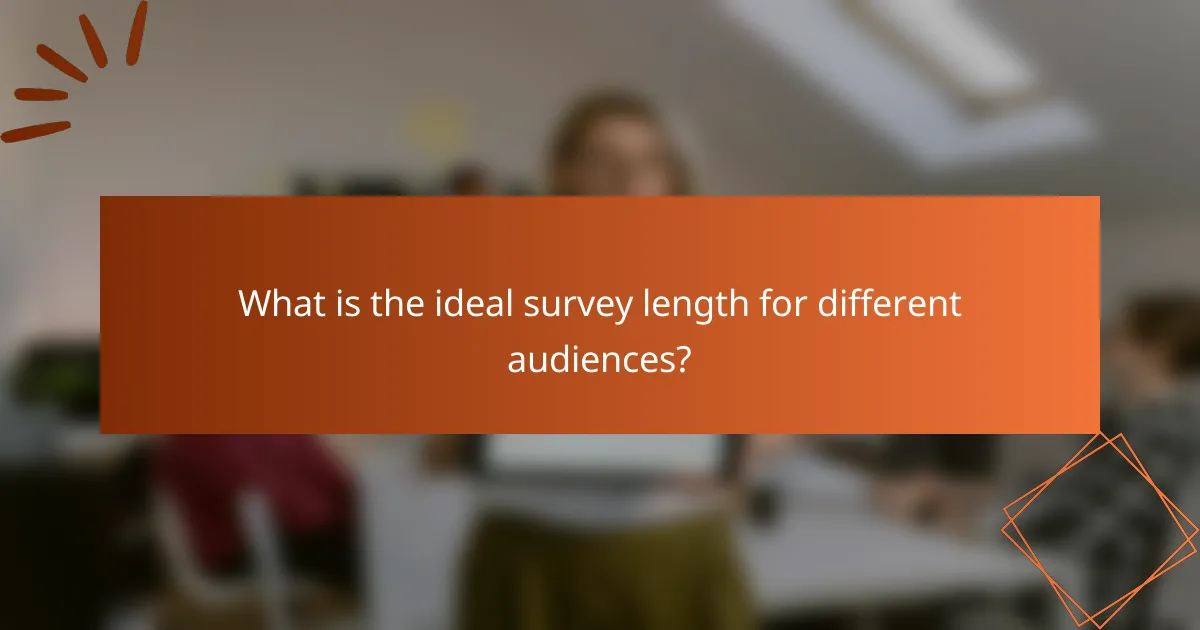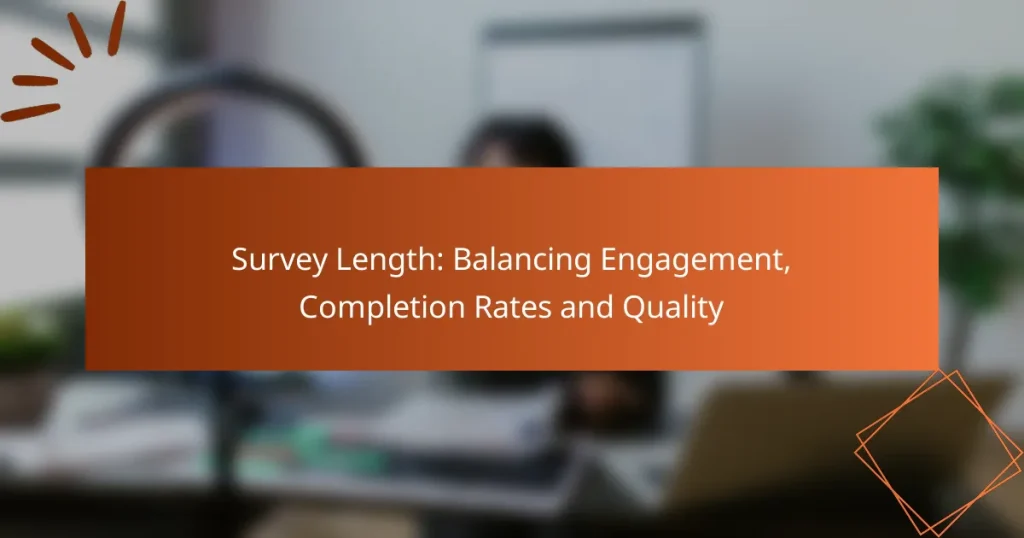Finding the optimal survey length is essential for maximizing completion rates while ensuring data quality. Striking a balance between brevity and the depth of information is key, as shorter surveys tend to engage respondents better, yet longer surveys can offer valuable insights if designed thoughtfully. Understanding your audience’s preferences will help in crafting surveys that maintain engagement without sacrificing the richness of the data collected.

How to optimize survey length for higher completion rates?
To optimize survey length for higher completion rates, aim for a balance between brevity and the depth of information needed. Shorter surveys generally lead to better response rates, but it’s crucial to include targeted questions that maintain engagement.
Shorter surveys improve response rates
Surveys that are concise tend to attract more participants and yield higher completion rates. Aim for a duration of 5 to 10 minutes, as this range is often manageable for respondents. Excessively long surveys can lead to fatigue, resulting in drop-offs.
Consider using a maximum of 10 to 15 questions to keep the survey focused. This approach not only respects the respondents’ time but also increases the likelihood of thoughtful answers.
Targeted questions enhance engagement
Including targeted questions that are relevant to the respondent’s experience can significantly boost engagement. Tailor questions to specific demographics or interests to make the survey feel personalized and relevant.
Use a mix of question types, such as multiple-choice and open-ended questions, to maintain interest. This variety can help keep respondents engaged throughout the survey, enhancing the quality of the data collected.
Use progress indicators to motivate respondents
Progress indicators can effectively motivate respondents by showing them how far along they are in the survey. A simple visual bar or percentage completion can reduce anxiety about the time commitment involved.
Consider displaying progress updates after every few questions. This tactic not only encourages completion but also reassures respondents that they are nearing the end, which can lead to higher overall satisfaction with the survey experience.

What is the ideal survey length for different audiences?
The ideal survey length varies by audience, balancing engagement, completion rates, and data quality. Generally, shorter surveys yield higher completion rates, while longer surveys can provide more in-depth insights if the audience is appropriately engaged.
General audience: 5-10 minutes
For a general audience, surveys should ideally take between 5 to 10 minutes to complete. This duration keeps participants engaged without overwhelming them, making it more likely they will finish the survey.
To achieve this, focus on clear and concise questions. Limit the number of open-ended questions, as they require more time to answer. A well-structured survey with a mix of multiple-choice and rating scale questions can enhance the experience.
Business professionals: 10-15 minutes
Business professionals are typically willing to invest 10 to 15 minutes in a survey, especially if it addresses relevant topics. This audience often expects a higher level of detail, which can justify the longer length.
When designing surveys for this group, ensure that questions are directly applicable to their work or industry. Including a few targeted open-ended questions can provide valuable qualitative insights without significantly increasing completion time.
Academic research: 15-20 minutes
Surveys aimed at academic research can extend to 15 to 20 minutes, as participants are usually more tolerant of longer formats when they understand the purpose. This length allows for comprehensive data collection, which is essential for robust analysis.
To maintain engagement, clearly communicate the survey’s objectives and relevance. Consider offering incentives, such as gift cards or entry into a prize draw, to encourage participation and completion.

How does survey length affect data quality?
The length of a survey significantly impacts data quality by influencing respondent engagement and completion rates. Longer surveys can lead to fatigue, while concise surveys often yield clearer and more reliable insights.
Longer surveys may lead to fatigue
As survey length increases, respondents may experience fatigue, which can result in lower quality responses. This fatigue often leads to rushed answers or disengagement, ultimately skewing the data collected.
To mitigate fatigue, aim for surveys that take no more than 10-15 minutes to complete. If longer surveys are necessary, consider breaking them into shorter sections or using progress indicators to keep respondents informed and engaged.
Concise questions yield clearer insights
Concise questions are essential for obtaining clear and actionable insights. When questions are straightforward and to the point, respondents are more likely to understand them and provide thoughtful answers.
Use simple language and avoid jargon to enhance clarity. Aim for questions that can be answered in a few seconds, and consider limiting the number of open-ended questions, as they require more time and thought from respondents.

What are the best practices for crafting engaging surveys?
To create engaging surveys, focus on clarity, visual appeal, and personalization. These elements help maintain participant interest and improve completion rates while ensuring high-quality responses.
Use clear and concise language
Clear and concise language is essential for effective survey design. Avoid jargon and complex terminology that may confuse respondents. Instead, use straightforward wording that conveys questions directly.
Keep questions short and to the point, ideally under 20 words. This helps respondents quickly understand what is being asked, reducing the likelihood of frustration and abandonment.
Incorporate engaging visuals and formats
Visual elements can significantly enhance survey engagement. Consider using images, charts, or infographics to illustrate questions or options, making the survey more appealing and easier to navigate.
Utilize varied formats, such as sliders for rating scales or multiple-choice questions with images. This not only captures attention but also caters to different preferences in how people interact with surveys.
Personalize questions based on demographics
Personalizing survey questions based on demographics can lead to more relevant and insightful responses. Tailor questions to reflect the background, interests, or experiences of different respondent groups.
For example, if surveying a diverse audience, consider segmenting questions by age or location to gather more targeted data. This approach can improve engagement and ensure that the survey resonates with participants.

What tools can help analyze survey length impact?
Several tools can effectively analyze the impact of survey length on engagement and completion rates. Utilizing platforms like SurveyMonkey and Google Forms can provide valuable insights into how survey length influences participant behavior and data quality.
SurveyMonkey for engagement metrics
SurveyMonkey offers robust engagement metrics that help assess how survey length affects participant interaction. You can track completion rates, time spent on each question, and drop-off points, which are crucial for understanding where respondents lose interest.
To maximize insights, consider setting up A/B tests with varying survey lengths. For example, compare a 10-minute survey against a 5-minute version to see which yields higher completion rates. This approach allows you to identify an optimal length that balances engagement and data quality.
Google Forms for response tracking
Google Forms provides straightforward tools for tracking responses and analyzing survey length impact. You can view response times and completion rates in real time, allowing for quick adjustments if needed.
Utilize the built-in charts and graphs to visualize data trends related to survey length. For instance, if you notice a significant drop in responses after a certain number of questions, it may be beneficial to shorten the survey or rephrase questions for clarity. Regularly reviewing this data can help maintain high-quality responses while ensuring participant engagement.

What are common pitfalls in survey design?
Common pitfalls in survey design include overly long surveys that discourage completion and ambiguous questions that confuse respondents. Both issues can significantly impact engagement and the quality of the data collected.
Overly long surveys lead to drop-offs
Surveys that are too lengthy often result in high dropout rates, as respondents may lose interest or feel overwhelmed. Ideally, surveys should be designed to take no more than 10-15 minutes to complete, which is generally considered the upper limit for maintaining engagement.
To mitigate drop-offs, consider breaking longer surveys into shorter sections or using progress indicators to inform respondents of their completion status. This approach can help maintain motivation and encourage full participation.
Ambiguous questions confuse respondents
Ambiguous questions can lead to misunderstandings and unreliable responses. When questions are unclear, respondents may interpret them differently, resulting in data that does not accurately reflect their opinions or experiences.
To avoid confusion, use straightforward language and specific wording. For example, instead of asking, “How often do you use our service?”, specify a timeframe such as “In the past month, how many times did you use our service?” This clarity helps ensure that respondents provide accurate and meaningful answers.

How to balance survey length with respondent experience?
Balancing survey length with respondent experience involves optimizing for engagement while ensuring high completion rates and quality responses. A well-structured survey typically ranges from 5 to 15 minutes, depending on the complexity of the questions and the target audience.
Understanding respondent fatigue
Respondent fatigue occurs when participants lose interest or become overwhelmed by a lengthy survey, leading to incomplete or low-quality responses. Keeping surveys concise and focused helps mitigate this issue, as shorter surveys tend to maintain higher engagement levels.
To combat fatigue, consider using engaging question formats, such as multiple-choice or rating scales, which can be quicker to answer than open-ended questions. Aim for a balance where the survey is long enough to gather necessary data but short enough to keep respondents motivated.
Optimal survey length
The optimal survey length varies based on the audience and topic, but surveys should generally be designed to take no more than 10 to 15 minutes. For specialized audiences or complex topics, consider extending to 20 minutes, but be mindful of potential drop-off rates.
As a rule of thumb, each question should take about 30 seconds to answer. Therefore, a 10-minute survey would ideally contain around 20 questions. Testing different lengths with a pilot group can help determine the sweet spot for your specific survey.
Strategies for maintaining quality
To maintain quality in responses while balancing length, prioritize essential questions and eliminate any that are redundant or irrelevant. Use skip logic to tailor the survey experience based on previous answers, ensuring that respondents only see questions that apply to them.
Additionally, consider incorporating incentives to encourage completion. Offering small rewards, such as gift cards or entry into a prize draw, can significantly boost response rates without compromising the quality of the data collected.
Testing and iterating
Regularly testing and iterating on your surveys is crucial for finding the right balance between length and respondent experience. Use A/B testing to compare different versions of your survey, adjusting lengths and formats based on real-time feedback and completion rates.
Gather insights from respondents about their experience and use this data to refine future surveys. Continuous improvement ensures that you adapt to changing preferences and maintain high-quality data collection over time.


